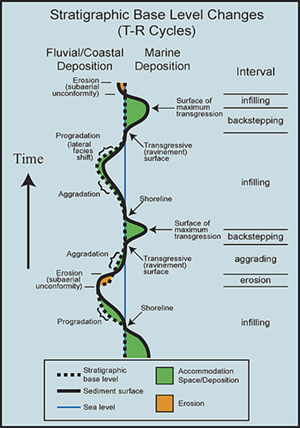Historically, the exploration strategies of companies drilling in the onshore Gulf of Mexico area consisted of utilizing seismic data to identify the crest of a salt feature for drilling and resource development. In the 1990s, researchers at the University of Alabama published papers on the importance of stratigraphic analysis (reservoir distribution, depositional and diagenetic characteristics, and reservoir quality) in the formulation of an effective exploration strategy. The next potential advance is the formulation of exploration strategies that are based on the knowledge of evolving geoscientific concepts, such as T-R cycles, that are designed to target stratigraphic traps. This advance will require the development of more accurate and higher resolution diagnostic and imaging systems. However, independent companies using these systems need geoscientific knowledge about the stratigraphic surface (conformity or unconformity), facies interface (sharp or gradational), and depositional rock fabric that they are imaging. This knowledge will assist them in maximizing the use of the imaging systems with the sensitivity to detect the subtleties of a stratigraphic trap and will serve to increase the success of this technology while reducing the costs associated with its use.
Project Results
The assessment of potential outcrops to be studied on the Gulf Coastal Plain and in Wyoming and Montana has been completed. Characterization of the nature of the physical bounding surfaces and stratal architecture of T-R cycles has been accomplished for outcrops along the Gulf Coastal Plain and for outcrops in Wyoming and Montana. The study of well log signature patterns has been completed. Well log responses characteristic of particular discontinuities associated with T-R cycles have been documented. The study of seismic reflection profiles has been completed. Reflection configurations and terminations inherent to the strata of T-R cycles have been characterized. The data and information resulting from the outcrop, well log, and seismic section studies have been integrated and are being used to develop the T-R cycle, depositional sequence, and sequence-stratigraphic models. The characterization data and information resulting from the outcrop, well log, and seismic studies have been used to develop a T-R cycle model for strata in the Mississippi Interior Salt Basin area. The known Mesozoic oil and gas reservoirs in the Mississippi Interior Salt Basin have been classified using this sequence stratigraphic framework based on T-R sequence terminology. These reservoirs have been classified into three categories: transgressive aggrading, transgressive backstepping, and regressive infilling. Exploration strategies for identifying specific facies with reservoir potential and for identifying possible stratigraphic traps have been formulated using a sequence stratigraphic model in combination with the discovered reservoir classification.
Benefits
A better understanding of the concepts of sequence stratigraphy, T-R cycles, depositional systems, and lithofacies associations will facilitate the design and use of the needed imaging systems. With the use of advanced imaging systems and the understanding of these geoscientific concepts, companies can predict better where in the basin (margin or center) to search for undiscovered resources in stratigraphic traps. Also important is the study of the depositional fabric of continental facies and resulting reservoir architecture at the reservoir scale to target a specific portion of an eolian dune or fluvial channel. The results from this research will serve to expedite the development of the high-resolution imaging technology necessary to detect with accuracy the subtle stratigraphic trap and specific reservoir facies. The results will provide companies searching for these stratigraphic traps and specific reservoir facies with additional knowledge and insights for the design of new exploration strategies that will be required to target these traps and reservoirs.
Project Summary
The development and testing of the sequence stratigraphy model has been accomplished through integrated outcrop, well-log, and seismic studies of Mesozoic strata in the onshore Gulf Coast, Gulf of Mexico, North Atlantic, and Rocky Mountain areas. The known Mesozoic oil and gas reservoirs in the Mississippi Interior Salt Basin have been classified using this sequence stratigraphic framework based on T-R sequence terminology. These reservoirs have been classified into three categories: transgressive aggrading, transgressive backstepping, and regressive infilling. Exploration strategies for identifying specific facies with reservoir potential and for identifying possible stratigraphic traps have been formulated using a sequence stratigraphic model in combination with the discovered reservoir classification.
The project tasks completed to date are as follows:
- Characterized stratal architecture and the nature of the bounding surfaces of T-R cycles as observed from the study of out-crops.
- Characterized well-log signatures and associated discontinuities inherent to the strata of T-R cycles through well log analysis.
- Characterized the reflection configurations and terminations inherent to the strata of T-R cycles by studying seismic reflection profiles.
- Integrated the data resulting from characterization by outcrop, well-log, and seismic reflection study of strata of T-R cycles.
- Developed a T-R cycle (sequence) model for strata of the Mississippi Interior Salt Basin.
- Constructed a depositional sequence model for strata of the Mississippi Interior Salt Basin.
- Developed a sequence stratigraphy model for strata of the Mississippi Interior Salt Basin.
- Classified known petroleum reservoirs in the Mississippi Interior Salt Basin into the phases of T-R cycles.
Formulated exploration strategies for identifying specific facies with reservoir potential and for identifying possible stratigraphic traps using a sequence stratigraphic model in combination with the discovered reservoir classification.




